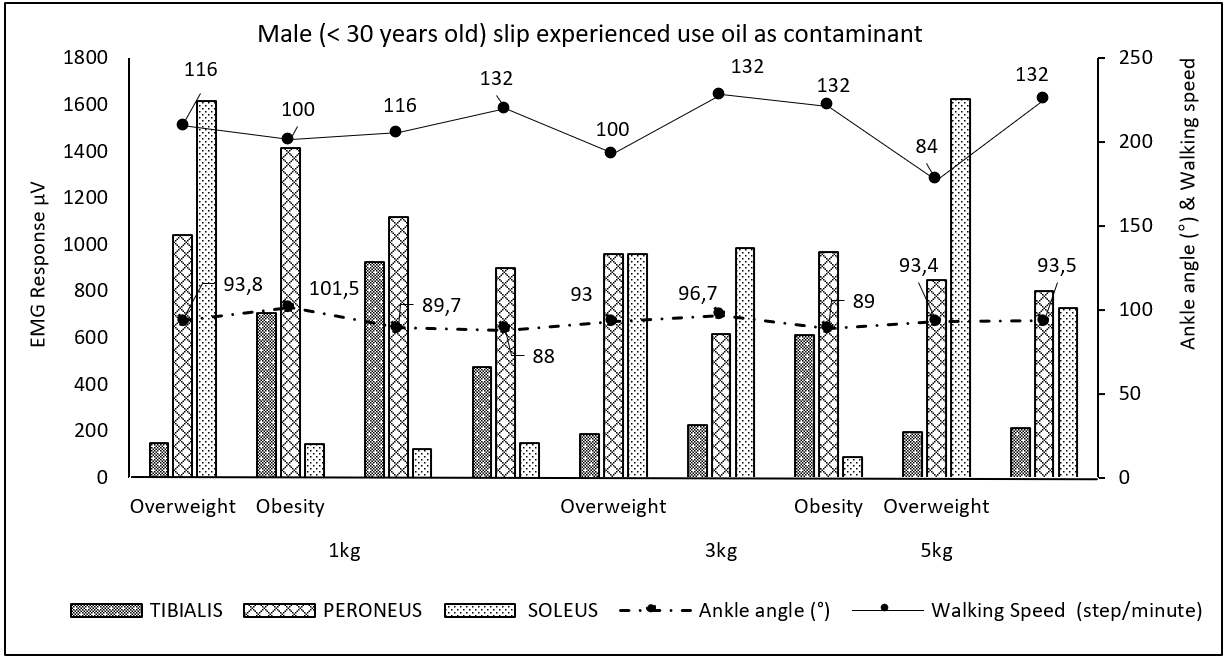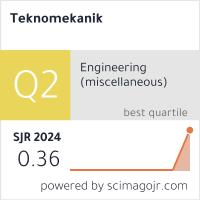An Analysis of Slip Incidence for Ankle Angle and Muscle Fatigue During Walking Activities
DOI:
https://doi.org/10.24036/teknomekanik.v4i2.10672Keywords:
Ankle angle, Muscle fatigue, Overweight, Obese, WalkingAbstract
Human walking speed exposes the higher potential to slip accident especially walking on the oily surface. Prolong walking during working will develop fatigue to the leg and certain body part. In a certain industry, there was a need that worker had to walk and standing in prolong before reaching their break. The aim of this study was to analyze the ankle angle and the muscle fatigue during walking and influence in slip incident. The study involves twelve health participants aged from 23 to 57 years old with a mean of BMI was 27.82 ± 4.01 kg/m2. The procedure will be explained the detail when the participant agreed. Vicon motion capture was used to record movements and the Electromyography (EMG) was used to record muscle fatigue activity. The finding shows that the slip occurred frequently for overweight and obese participants. The female participant experience slips more than a male participant. The range of ankle angle during slip was from 97.2 ± 6.7° for male participants and 112.5 ± 12.7° for female participants. The muscle Soleus and Tibialis were producing high muscles fatigue during slip occurrence. The results of the study show that muscle fatigue was significant with the occurrence of slipping during walking speed. Other findings presented that overweight and obese participants' significant slip occurred when walking on oily surfaces. Both aged groups represent the slip occurrence, there was no significant factor of aged during slip occurrence.
Downloads
References
Bureau of Labor Statistics. The Economics Daily, Injury and illness rates higher in special food services than in broader food services industry. U.S. Department of Labor, 2019.
Subramaniam, S., and Murugesan, S. Investigation of work-related musculoskeletal disorders among male kitchen workers in South India. International Journal of Occupational Safety and Ergonomics. 2015; 21: pp. 524-531.
Social Security Organization. Annual Report 2013. Malaysia, 2014.
Social Security Organization. Annual Report 2014. Malaysia, 2015.
Social Security Organization. Annual Report 2015. Malaysia, 2016.
Social Security Organization. Annual Report 2016. Malaysia, 2017.
Social Security Organization. Annual Report 2017. Malaysia, 2018.
Jeong, B. Y., & Shin, D. S. Characteristics of Occupational Accidents in Korean, Chinese, Japanese and Western Cuisine Restaurants. Human Factors and Ergonomics in Manufacturing & Service Industries. 2016; 26(3): 316–322.
Waters, T.R. and Dick, R.B. Evidence of health risks associated with prolonged standing at work and intervention effectiveness. Rehabilitation Nursing. 2015; 40(3): pp.148-165.
Rok Bavdek, Anže Zdolšek, Vojko Strojnik and Aleš Dolenec. Peroneal muscle activity during different types of walking. Journal of Foot and Ankle Research. 2018; 11(50).
Cycleform. Exercise Associated Muscle Cramps. 2015. [online] Available at: https://cycloform.com/blog/2015/10/24/exercise-associated-muscle-cramps [Accessed on 7 October 2019].
McGrath, T.M., Waddington, G., Scarvell, J.M., Ball, N.B., Creer, R., Woods, K. and Smith, D. The effect of limb dominance on lower limb functional performance–a systematic review. Journal of sports sciences. 2016; 34(4): pp.289-302.
Tudor-Locke, C., Aguiar, E.J., Han, H., Ducharme, S.W., Schuna, J.M., Barreira, T.V., Moore, C.C., Busa, M.A., Lim, J., Sirard, J.R. and Chipkin, S.R. Walking cadence (steps/min) and intensity in 21–40 year olds: CADENCE-adults. International Journal of Behavioral Nutrition and Physical Activity. 2019; 16(1): pp.1-11.
Yong, W.K., Tea, H.K., Mi, N.Y., Ye, S.Y., and Ji, H.L. Comparison of Activities of Tibialis Anterior, Peroneus Longus, and Tibialis Posterior Muscles according to Lunge Squats and Bulgarian Split Squats in a Healthy Population. Journal of KEMA. 2017; 1(1): pp. 26-30.
Kertis, Jeffrey D. Biomechanical Evaluation of an Optical System for Quantitative Human Motion Analysis. Master Theses. Milwaukee, Wisconsin; 2012.
Jones, T., Iraqi, A., & Beschorner, K. Performance testing of work shoes labeled as slip resistant. Applied Ergonomics. 2018; 68: 304–312.
Lockhart, T. E. Biomechanics of Human Gait - Slip and Fall Analysis. Encyclopedia of Forensic Sciences. 2013; 2: 466-476.
Leigh, J.A. A Study on the Effects of Obesity and Age on Balance Recovery after Slipping. Master Thesis. Blacksburg, VA; 2014
Nur Amirah Hanisah Hisham, Ahmad Faiz Ahmad Nazri, June Madete, Lilik Herawati and Jamaluddin Mahmud. Measuring Ankle Angle and Analysis of Walking Gait using Kinovea. International Medical Device and Technology Conference. 2017; 247-250.
Wan, J. J., Qin, Z., Wang, P. Y., Sun, Y., & Liu, X. Muscle fatigue: general understanding and treatment. Experimental & molecular medicine, 2017, 49(10), e384-e384.
Enoka, R. M., & Duchateau, J. Muscle fatigue: what, why and how it influences muscle function. The Journal of physiology, 2008, 586(1), 11-23.

Downloads
Published
Issue
Section
License
Copyright (c) 2021 Sharifah Aznee Syed Ali, Seri Rahayu Kamat, Momoyo Ito

This work is licensed under a Creative Commons Attribution 4.0 International License.




